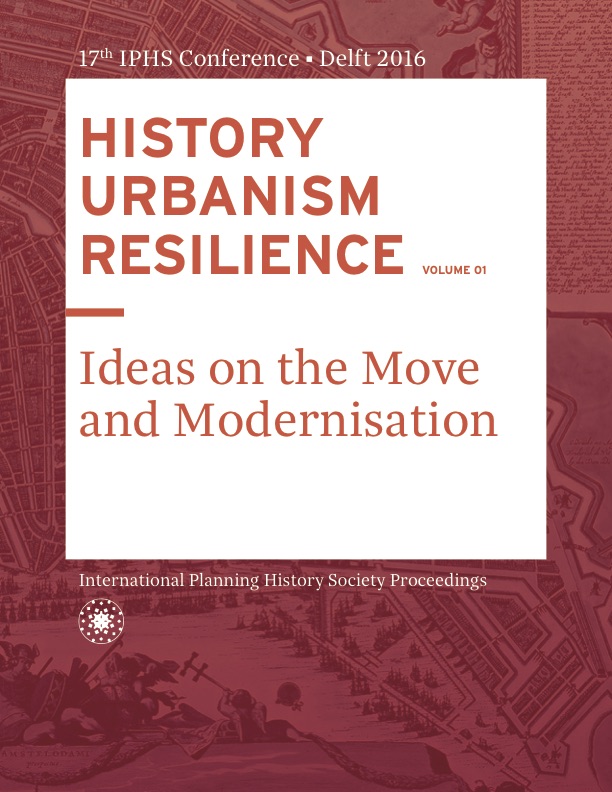The Regionalist Vision of Henry Wright: Lessons in Sustainability
DOI:
https://doi.org/10.7480/iphs.2016.1.1210Abstract
Though lesser known than his Regional Planning Association of America colleagues – Clarence Stein, Lewis Mumford, and Benton MacKaye – Henry Wright played a key role in implementing and promoting critical regional planning ideals. In doing so, he embraced what Wheeler (2002) characterizes as “ecological regionalism” and more recently Berke (2008) describes as the “environmentally sustainable urban form” (p. 395). After earning his degree in architecture at the University of Pennsylvania, Wright spent his early professional years in the office of nationally prominent landscape architect George Kessler. Here he gained a sensitivity to site design, including grading and infrastructure development, and a broadening understanding of natural systems and networks. His subsequent employment with the Emergency Fleet Corporation designing communities for war workers during World War I, established his expertise in economically designing communities. During the 1920s and until his death in 1936, he applied this expertise to design communities that reflect many of the current criteria of sustainability, new regionalism, and green infrastructure.This paper examines archival writings of Wright, his contemporaries, and more recent explorations of sustainability, green infrastructure, and new regionalism to assess the elements of Wright’s community planning, site design, and broader regionalist ideas that prefigured these modern concepts. As Planning Advisor to the New York Commission of Housing and Regional Planning, his contributions towards a 1926 proposal for statewide planning forms a critical component of this examination. Further, his lesser known articles on town planning, land development, and the economics of housing design offer a sustained perspective regarding the dynamics of his contributions to regionalism. These include conceptual new town designs integrating intensive mixed use urban areas punctuated with outlying parks as part of a balanced regional network of communities. A comparative and critical analysis of these contributions within the context of the contributions of his RPAA colleagues and regional scholarship today highlights his legacy as an architect, landscape architect, and planner.
References
Berke, Philip R. “The Evolution of Green Community Planning, Scholarship, and Practice.” Journal of the American Planning Association, 74, no. 4 (2008): 393-407.
Berke, Philip R., and Maria Manta Conroy. “Are We Planning for Sustainable Development?” Journal of the American Planning Association 66, no. 1 (2000): 21–33.
Fishman, Robert. “The Metropolitan Tradition in American Planning.” In The American Planning Tradition: Culture and Policy edited by Robert Fishman, 64-85. Baltimore: The Johns Hopkins University Press, 2000.
Geddes, Patrick. Cities in Evolution. In Patrick Geddes: Spokesman for Man and the Environment edited by Marshall Stalley, 111-285. New Brunswick, NJ: Rutgers University Press, 1972.
Grant, Jill. Planning the Good Community: New Urbanism in Theory and Practice. New York: Routledge, 2006.
Larsen, Kristin. “Planning and Public–Private Partnerships: Essential Links in Early Federal Housing Policy.” Journal of Planning History 15, no. 1 (2016): 68-81.
___. “The Radburn Idea as an Emergent Concept – Henry Wright’s Regional City.” Planning Perspectives 23, no. 3 (2008): 381-395.
Lubove, Roy. Community Planning in the 1920’s: The Contribution of the Regional Planning Association of America. Pittsburgh: The University of Pittsburgh Press, 1963.
Neuman, Michael. “Regional Design: Recovering a Great Landscape Architecture and Urban Planning Tradition.” Landscape and Urban Planning 47 (2000): 115-128.
New York Commission of Housing and Regional Planning. Report of Commission of Housing and Regional Planning to Governor Alfred E. Smith and to the Legislature of the State of New York. May 7, 1926.
Resettlement Administration. Greenbelt Towns: A Demonstration in Suburban Planning. September, 1936.
Sharifi, Ayyoob. From Garden City to Eco-urbanism: The quest for sustainable neighborhood development. Sustainable Cities and Society, 20 (January 2016): 1-16.
Spann, Edward K. Designing Modern America: The Regional Planning Association of America and Its Members. Columbus, OH: Ohio State University Press, 1996.
Sussman, Carl. “Introduction.” In Planning the Fourth Migration: The Neglected Vision of the Regional Planning Association of America, edited by Carl Sussman, 1–45. Cambridge, MA: MIT Press, 1976.
Talen, Emily. New Urbanism and American Planning: The Conflict of Cultures. New York: Routledge Taylor and Francis Group, 2010.
Tarn, David E. “Co-operative Group Planning: A Suburban Development.” Architectural Record 34, no. 5 (1913): 467-475.
Welter, Volker. Biopolis: Patrick Geddes and the City of Life. Cambridge, MA: MIT Press, 2002.
Wheeler, Stephen. “The New Regionalism: Key Characteristics of an Emerging Movement.” Journal of the American Planning Association 68, no. 3 (2002): 267-78.
Worley, William S. “Kansas City Architects George Kessler, Henry Wright, and Sid and Herbert Hare.” Kansas History 2, no.3 (1997): 192-205.
Wright, Henry. “The Autobiography of Another Idea.” Western Architect 39 (September 1930), reprint; New York: Regional Planning Association of America, 1930, n.p. Box 18, CSP/CUL.
___. “The Place of the Apartment in the Modern Community.” Architectural Record 67, no. 3 (1930): 207-238.
___.“To Plan or Not to Plan.” Survey Graphic (October 1932): 468-469.
___. Rehousing Urban America. New York: Columbia University Press, 1935.
___. “The Road to Good Houses.” In Planning the Fourth Migration: The Neglected Vision of the Regional Planning Association of America, edited by Carl Sussman, 121-128. Cambridge, MA: MIT Press, 1976.

